ASUS Zenbook (UX21) Review
by Anand Lal Shimpi on October 22, 2011 8:00 PM ESTThe Display
To hit a $999 price point with the hardware that it has, ASUS (like Apple) had to give up the pursuit of an IPS panel in the Zenbook. As we saw with the MacBook Air however, it is quite possible to select a decent TN panel at this price point. Was ASUS able to? Sort of.
In the interest of beating Apple, ASUS pursued a brighter overall display design. ASUS even selected a new optical film for the Zenbook's panel that helps improve brightness. As a result, the Zenbook UX21 is brighter than the 11-inch MBA. Given the sad state of most PC notebook displays, the Zenbook fares very well when compared to its PC brethren as well. Very few PC displays are as bright as what we saw with the Zenbook. In fact, a quick look at our PC notebook Bench database reveals the Zenbook is the brightest PC notebook we've ever tested.
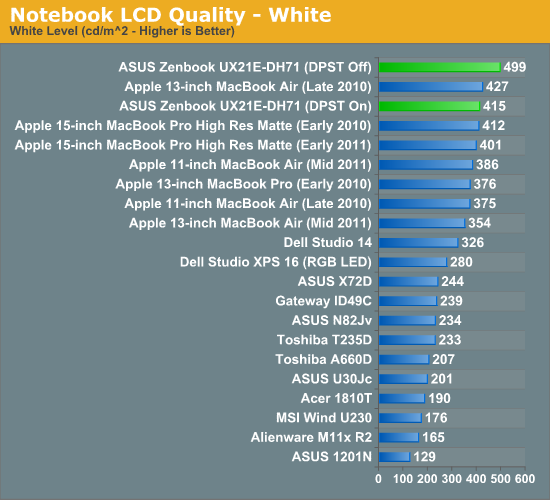
The brightness does come with a downside: higher than desirable black levels. The lowest black level I measured on the UX21 was 1.1 nits using our X-rite i1Display 2, however in the center of the display I measured 1.20 nits. This is nearly double the value I recorded on the 11-inch MacBook Air. Although not terrible, the black levels on the Zenbook's panel could use some improvement. Note that these results were generated with Intel's DPST (Display Power Savings Technology) enabled. Without DPST enabled, the black levels jump even higher to 2.7 nits in our test, while the white point makes it to just under 500 nits. Contrast ratio actually goes down since the impact on black levels is greater than the increase in white point brightness. ASUS ties DPST state to power mode; it's enabled in High Performance mode (on AC power) but disabled in Battery Saver mode (on DC power). You can override these settings by manually configuring the power plan in the Windows 7 control panel.
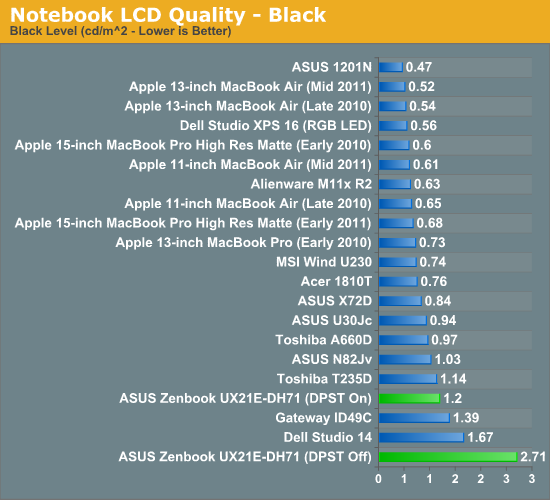

ASUS sent along test data that showed its black levels were only around 40% higher than the 11-inch MBA; however, after a couple of nights of trying I couldn't get any better than the numbers I've presented here. ASUS does use a more sophisticated colorimeter, but its test data for the MacBook Air seems to match up with mine whereas its Zenbook data is considerably better than what I have here.

ASUS' Display Test Data
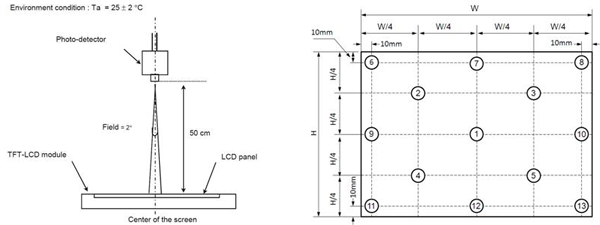
It's possible I simply received a bad unit, or perhaps I just lost the panel lottery with the UX21, but I can only report on the data I was able to generate. The Zenbook UX21's display is very bright, but it neeeds better black levels.
In terms of color quality and gamut, the Zenbook is very competitive once calibrated. You get better color gamut than a MacBook Air and comparable color accuracy. However, the out of the box calibration isn't all that great, as ASUS doesn't calibrate white to 6500K at the factory (it's set to 7700K by default). The system does ship with a digital color management system called Splendid, but you don't have many options beyond moving RGB or color temperature sliders. If ASUS wants to compete in this space I do believe it needs to calibrate panels at the factory.
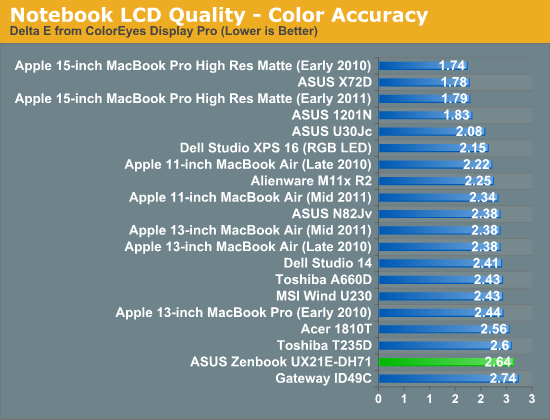
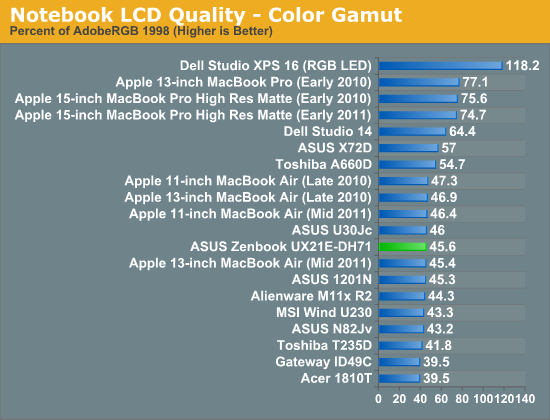
Viewing angle is my only other complaint about the UX21's panel. It seems as if in the quest for better specs, ASUS didn't pay enough attention to viewing angles. Although the UX21 uses a TN panel it is possible to improve viewing angle through the use of a compensation film in front of the polarizer in the display stack. Most TN panels are paired with some form of wide viewing angle film to improve their characteristics, but Apple actually uses an extra wide view compensation film in the case of the MacBook Air to give it slightly more IPS-like viewing angles. The downside to using this film is it reduces light output, which in turn improves black levels (peak contrast ratio is generally unaffected since you clip both white and black levels).
ASUS opted against using the same EWV film as Apple, in part to improve overall brightness as well as guarantee a little bit of off-angle privacy. While the result is a brighter display than what Apple was able to accomplish, the UX21 is far more sensitive to viewing angles. As you can see in the shots below, the UX21 looks great straight on but anything off center is significantly worse. In most situations I didn't find this to be a huge problem as I was able to tilt the display a little farther back and prevent the display from getting too washed out.
Overall the display is better than the vast majority of what you find on PC notebooks, however a couple of key decisions kept ASUS from making it perfect. I have already fed my test data and suggestions back to ASUS engineering, who are currently evaluating options for the second generation UX series next year.
















109 Comments
View All Comments
KPOM - Sunday, October 23, 2011 - link
Nice review, as usual. The ASUS Zenbooks are the first credible competitors to the MacBook Air, in my opinion (far more than the Acer), in that they are nearly identically equipped, with some upgrades (faster SSD, better sound) at a lower price. Hopefully this pushes Apple a bit to do some upgrades for next year's Ivy Bridge MacBook Air (I wouldn't mind a better speaker and 6Gbps SSDs, and perhaps a small price drop for the upgraded models).C300fans - Monday, October 24, 2011 - link
I fail to see any lower price comparing with AIR.madmark4 - Thursday, November 3, 2011 - link
Seriously?Let me step you through it then:
1) Base MBA, $999. Slower processor, 64gb SSD, and 2gb ram.
2) Base UX21, $999. Faster processor, 128gb SSD, and 4gb ram.
Did you happen to see the lower prices there? I think most do.
sapi3n - Sunday, October 23, 2011 - link
my problem with this piece of hardware is in the interface. I've got a core 2 duo Asus laptop that is quite good, but the keyboard is like typing on a rope bridge, forcing me to carry an external keyboard for anything expansive. I wish this wonderful company would start with the keyboard, and work outward.twotwotwo - Sunday, October 23, 2011 - link
Sounds like you find the bad display contrast pretty maddening. Are you saying you'd advocate Windows users get a Macbook Air just because of it, though? It's $250 more (system cost + getting Windows Home Premium) plus the fuss of setting up Boot Camp, and folks might prefer the Zenbook for the better SSD, the resolution, the USB 3/VGA/HDMI/Ethernet connection options, etc. The Air seems like a choice for graphics-focused folks or people looking for *the* most premium ultraportable there is, but it doesn't seem like the shoo-in choice for a typical mobility-focused Windows user.But if the display *is* a total dealbreaker I'd love to hear more about why. A dull grey backlight bleed sounds annoying, but reflections from a glossy screen coating seem worse to me and reviewers seem to mostly accept the trend towards glossy displays. But I can't really do any comparisons since I don't have a Zenbook sitting around (or a ThinkPad X1, which seems to have the same contrast level), so your insight would be interesting here.
Does sound like a pity about the Asus's touchpad. :/
agent2099 - Sunday, October 23, 2011 - link
I'm disappointed with the maximum resolution for the microHDMI port. It only does 1900x1080 which means you cannot connect it ton a 24" monitor at native res (1900x1200). Is this just a limitation of the microHDMI port or for all intel HD graphics. For some of the other laptops out there that have full size HDMI, can you output 1900x1200 native?repoman27 - Monday, October 24, 2011 - link
The HD Graphics in 2nd Gen Intel Core processors support HDMI 1.4 features, one such feature being the Micro HDMI connector itself. Intel is a bit vague as to the maximum resolution using HDMI, although they clearly note that 2560x1600 is achievable using DisplayPort 1.1. It's odd that the spec here is for less than 1920x1200 since even HDMI 1.0 supported resolutions that high. Although 1920x1200 displays seem to be going the way of the dodo due to the onslaught of 1920x1080 "Full-HD" panels, it's still curious to see such a seemingly arbitrary limitation.Watwatwat - Monday, October 24, 2011 - link
if you are just using this anywhere, on your lap even, viewing angle becomes key, esp with such a small short display. they really dropped the ball going brighter instead of wider.rs2 - Monday, October 24, 2011 - link
Sorry, but you must be dreaming. Either that, or your requirements for labeling something "extremely responsive" have seriously been slipping. Extremely responsive doesn't mean "static content scrolls smoothly across the screen and looks pretty", it means more along the lines of "when I launch an app, I don't have to wait 5 to 10 seconds for it to load and become usable" and "I can switch easily and quickly between multiple applications, without losing my view of any of them if I so choose" and "my device doesn't need a full minute to power on from a cold start".Today's tablets are a world away from being "extremely responsive" by any reasonable set of criteria.
alxx - Monday, October 24, 2011 - link
So any chance of giving this a review with it running linux ?fedora 15 or ubuntu ?
Is it full bluetooth 4 support or limited ?
Does it support HS , low power and low energy or ???